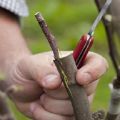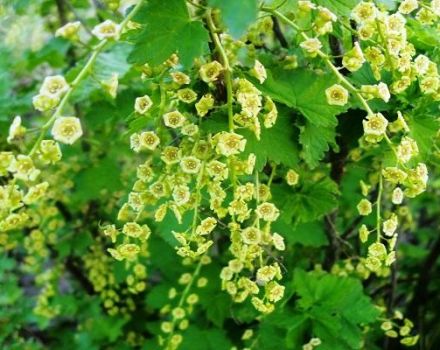What to do when a cherry fly appears, how to treat and spray to get rid of
Every summer, gardeners are faced with a variety of pests, the control of which is an important part of plant care. The cherry variegated fly damages the harvest of cherry, sweet cherry, apricot, barberry, honeysuckle. Distributed in Europe, Central Asia, Western Siberia and Altai. The fruits infect insect larvae that feed on ripe pulp. Damaged by a cherry fly, they are not suitable for fresh consumption or preservation.
Description of the pest
The cherry fly is a dipteran insect, the average size of an adult is 3-5 mm. The body is black, shiny, hairy, with stripes on the abdomen and a bright yellow shield on the back. On transparent wings with yellowish veins, dark transverse stripes are located at the base. Most of the head is occupied by green compound eyes.
Reasons for the appearance
The cherry fly can destroy from 30 to 100% of the fruit, sweet varieties of medium and late ripening are affected. An early crop is harvested before the fly begins to reproduce. The appearance of the parasite is facilitated by dry, warm weather (from + 18 )С), the predominance of mid-season and late varieties of stone fruit trees on the site. The cherry fly can migrate from a nearby garden, expanding its habitat.
Active season
Depending on weather conditions, the garden pest appears from mid-May to late June. The female cherry fly feeds heavily before laying eggs. It collects the secretions of leaf fleas and aphids, as well as sap in the cracks in the trunk. The insect lives for about a month, actively in warm dry sunny weather. Lays one egg at a time in green fruits that are beginning to ripen. One individual is capable of infecting up to 150 fruits. In 10 days, larvae form, which eat the flesh, grow, and after 20 days they move underground, where they pupate at a depth of 5-7 cm.
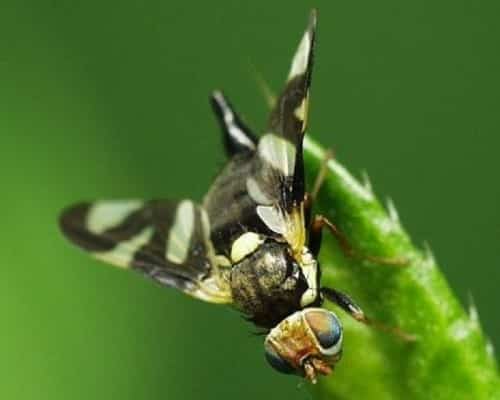
Cherry fly larvae are white or yellowish, legless, reaching 6 mm in length. During growth, they molt twice, after which they fall into the soil, where they stay until next spring. Under unfavorable climatic conditions, they can be in the ground, suspending the life cycle.
Control methods
In order to protect the harvest of stone fruit trees, you should know how to reliably get rid of cherry flies. The algorithm of actions is as follows:
- Timely identification of the pest in the garden.
- Fighting insects early.
- Protection during ripening and harvesting.
- Prevention.
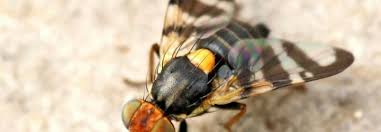
The gardener's struggle with the cherry fly begins long before depressions and spots appeared on the fruits, and the berries began to fade and fall off. The earlier the pest is detected, the more effective the measures will be.
How to identify a pest
To quickly identify an annoying insect in the garden, it is recommended to use sticky traps, which you can buy in the store or do it yourself. For a homemade trap, you will need to paint a sheet of thin plywood or cardboard yellow and prepare a sticky composition according to the following recipe:
- Castor oil - 2 tablespoons l.
- Liquid rosin - 1 tbsp. l.
- Jam or honey - 1 tbsp. l.
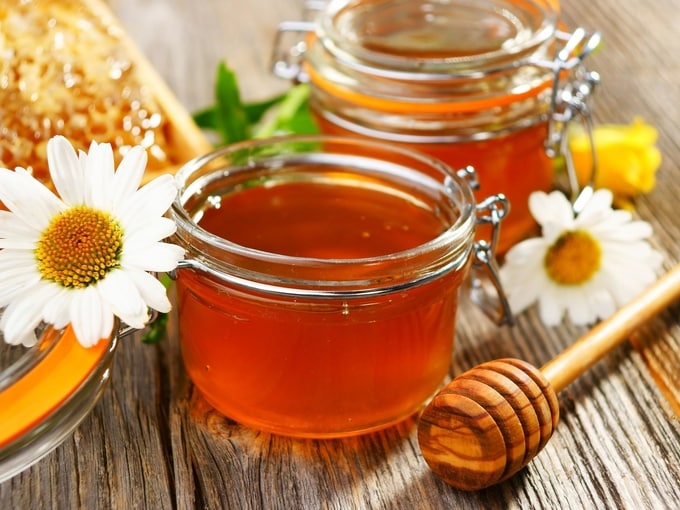
Heat oil and rosin in a water bath and mix until smooth, add aromatic sweetness to attract flies. Apply in a thin even layer on the prepared sheet and hang on the crown of the tree. More than 20 flies on a cardboard box - it's time to sound the alarm. Enough 3 traps for a garden of up to 5 hectares.
If in the previous year the cherry fly has already caused trouble, you need to place inverted boxes on the ground in the spring, immediately after the flowering of trees, in which the bottom has been removed, replaced with gauze. They will catch flies coming out of the soil with warming.
Some part of the insects can be destroyed in this way, but this will not solve the problem as a whole.
Early control of insects
If a harmful insect is found, you should immediately begin to combat it. In order to scare away uninvited guests, it is recommended to spray the crown of the tree with decoctions of pine needles, tobacco, wormwood, garlic or onion husks. Usually they take a pound of plant materials per 10 liters of water, but this ratio can be varied as desired. A strong plant smell can be enhanced by adding a solution of laundry soap.
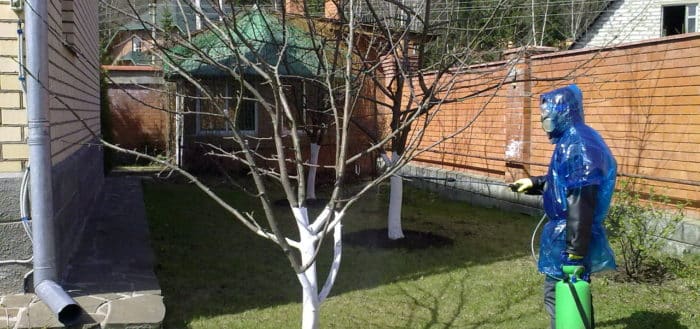
Do not forget that aphids and ants are active participants in the cherry fly's life cycle. Before you start to deal with the main pest, you need to take action against the other two types. The extermination of the aphid population in the garden is enough for the cherry fly to start looking for another habitat.
Protection during ripening and harvesting
If damaged berries are found, they must be removed from the branches and destroyed. Timely and fast harvesting in one step will help save it from more damage. The container for berries is covered with burlap in order to make it easier to collect the fallen larvae. In this case, you can not leave fruits on the branches and carrion on the ground. It is advisable to destroy or bury the affected drupes to a depth of 50 cm.
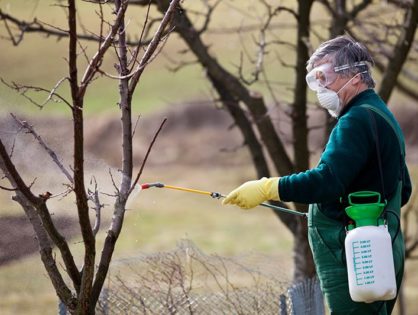
It doesn't matter what you have to spray the trees against parasites - with modern means or folk - you need to process both the crown and the soil around.
DIY traps
In addition to velcro, bait traps are also made from plastic and glass jars. For a plastic bottle trap you will need:
- Bottle of 1.5 or 2 liters.
- Kvass or beer.
At the top of the eggplant - at the level of the hangers, you should cut out 3 windows, pour the liquid inside, which will attract insects with a smell, and hang it on a branch.

A trap from a glass jar is made as follows: a spoiled product is put in a jar - preferably a fruit, covered with a funnel and fixed along the neck with electrical tape. Insects, attracted by the smell of the fermented product, will penetrate through the funnel, but will not be able to get out. The baits need to be cleaned periodically - change the liquid and remove insects.
Chemical treatment
The most powerful cherry fly control agents are insecticides. This is the "heavy artillery" in horticulture. The preparations are toxic and must be applied no later than 20 days before harvest. It is better to poison flies during the period of supplementary feeding, preventing the laying of eggs.The most popular are Aktellik, Phasis, Pyrethrum, Paris Green, Mospilan, Confidor. It is recommended to apply them 10 days after the fly leaves the ground and again after another 12 days. Iskra, Karate and Molniya are no less effective. Insects tend to adapt to poisons, so the means must be alternated.
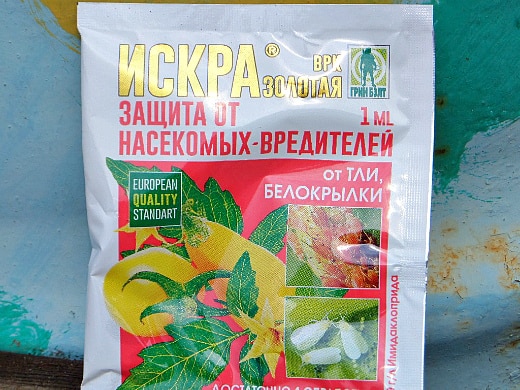
In addition to insecticides, biological products are used. They are softer and have no waiting period. "Bicol", "Bitoxibacillin", "Lepidocid" are used in the phase of bud formation and after flowering, helping to fight larvae and caterpillars.
"Gaupsin" acts against pests and diseases, treatment should be carried out every 2 weeks, and more often in the rainy season.
Early varieties are not processed. High results are achieved by combining insecticides and biological products. If you do not engage in the systematic destruction of the pest throughout the season, its population will increase from year to year, which will eventually lead to the death of plants. It is important that the same pest control measures are taken in adjacent areas.
Prevention
Precautionary measures are designed to prevent the larvae from turning into flies, flying out of the ground and laying eggs. To do this, several times a year, the ground under the trees is dug up and the pupae are manually removed. It is recommended to add soil insecticides "Gromoboy", "Medved-tox", "Prestige".
In the fall, the trunks are poured with diluted clay, and in the spring they are covered with gauze or agrofibre to prevent flies from coming to the surface. After harvesting, the affected fruits must be burned, the aisles must be sprayed with Hexachloran. Be sure to regularly remove fallen leaves and dry branches from under the tree. It is recommended to hang birdhouses in the garden so that the birds help fight insects. It is recommended to plant calendula, marigolds, marigolds, mint, lemon balm in the aisles, the smell of which scares away aphids and cherry flies.






